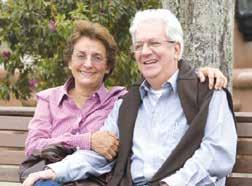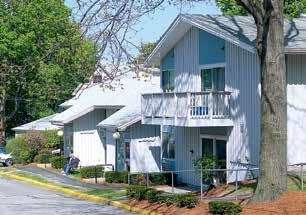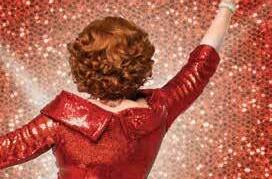Salem museum’s head gardener









People today can spend nearly half their lives over the age of 50. That's a lot of living. So, it helps to have a wise friend and fierce defender like AARP in your corner and in your community so your money, health and happiness live as long as you do.


AARP offers information and support for caregiving, financial planning, volunteering and events to help you achieve
goals
stay connected.
By Mike Festa, state Director aarP Massachusetts Mike Festa
On June 29, 2022, AARP Massachu setts announced that it would be awarding several organizations across the Bay State with the 2022 AARP MA Community Challenge Grants. These grantees will be implementing quick-action projects that help commu nities become more livable in the long term by improving public places, public trans portation, housing, diversity, equity and inclu sion, digital access and civic engagement — with an emphasis on the needs of adults age 50 and over.
• Cambridge Grantee: Cambridge Community Television – plans to deploy pop-up mobile media and technology labs throughout the city and host mini classes in com puter technology and digital liter acy.
• Gloucester Grantee: Backyard Growers will use the grant to fund their project that is provid ing residents in Senior Housing in Gloucester and surrounding com munities with training and sup port on flexible gardening options for smaller spaces via grow bags.
• Lanesborough Grantee: Heart and Soil, who will be using their grant to fund a community pro duce program which supports lo cal small farms by purchasing their produce and delivering it to com munity seniors with disabilities.
• Boston Grantee: The Trustees of Reservations – The Trustees will
Mike
www.fiftyplusadvocate.com.
be repairing a hazardous walkway at Southwest Corridor Community farm, and four raised-bed gardens will be built for disabled gardeners at Savin & Maywood Community Garden.
• Chelmsford Grantee: Chelms ford Public Library – Indigenous people’s contributions will be ac knowledged with 11 informational kiosks and five freestanding mini libraries, plus programs focusing on the arts and history.
• South Dennis Grantee: Dennis Center for Active Living – In a cor ner on the Center for Active Living grounds, there will be six raisedbed gardens and two ADA-compli ant benches placed on a new, con crete surface.
• Westport Grantee: Westport Council on Aging – a fixed-route transportation service for older adults will be established, oper ating one day per week between common shopping, banking and medical destinations in this rural community.
• Worcester Grantee: MassBike –Intergenerational bicycling will be encouraged by pairing 20 teenaged cyclists with 20 older recipients in an ongoing program that awards free e-bikes. There will also be five bicy cle workshops as well as group rides.
AARP Massachusetts is commit ted to working with communities to improve residents’ quality of life through tangible changes. We are proud to collaborate with this year’s grantees as they make immediate im provements in their communities to jumpstart long-term change, especial ly for Bay Staters 50 and over.
This is just part of the largest group of grantees to date with $3.4 million awarded among 260 organi zations nationwide. Learn more about AARP’s livable communities work at www.aarp.org/livable.
REGION - If you’re feeling like your place is a bit crowded and cluttered, maybe it’s time to sell some of that older stuff. But how do you do it?
Though old stuff may seem like junk to you, to someone else, it could be a treasure.
“Almost every item has some val ue,” says Phil Kittredge of Westbor ough, who with his wife, Donna, has been involved with antiques for over four decades. “There are many dif ferent avenues,” explained Kittredge, “for disposing of your items.”

If you’ve inherited a house full of things, Kittredge advises an onsite es tate sale if you want to sell large items, such as furniture. Companies hired for this service will manage everything. Usually along with the fee for this ser vice, they will get a commission for each item sold. For small items, such as coins, it’s best to sell in an auc tion-style setting, online or live. The auction house will collect a commis sion for selling your item.
Many might advise you to sell your stuff on eBay or LiveAuctioneers. Kittredge warns there’s a lot of work involved in using this route so it may not be what you want to do. But if you go this way, he suggests searching the completed auctions on these sites to determine a final selling price for your things.
Kittredge says to be prepared to
be a bit disappointed. “Many items thought to be rare before eBay, are now found online frequently,” he noted.
This simply means your item is not so unique as you thought and that means not worth as much as you may have hoped for.
It’s important to remember that just because what you’ve got is old ― even very old ― it may not be very valuable. Kittredge explains that con dition is key in evaluating items and placing a value on them.
“A crack, chip or missing piece can reduce an item’s value by at least fifty percent or more,“ he said.
Some types of old items are always in demand, such as toys.
“Toys are one of the few items that are always in demand,” said Kittredge. “Many buyers are eager to obtain their favorite toy from childhood. At a re cent auction, a plastic Superman doll from 1940 sold for over $3,000. Having the original box for that 1940s toy can even double the price.”
However you decide to sell your items, Kittredge explained that the
true value of a piece is what the final bidder will actually pay at auction or what the customer will pay at your local antique shop. Don’t be greedy; price your item fairly and it will sell.

If you are pretty sure you’ve got some things that may be valuable, then you should take them to a local reputable antique shop or auction house. Kittredge advises to take your item to several antique shops. Don’t settle for the first offer. Check out con signment shops too.
“I usually tell someone to take their valued possession to an auction house,” said Kittredge. “Even your lo cal auction house will most likely be able to determine if an item has spe cial significance and value. It pays to investigate and find an auction house that specializes in the type of item you’ve got.”
You never know; you could be very lucky. The federal credentials for former federal agent Eliot Ness re cently sold for $40,000.
“This just reminds us that there could be valuable and important treasures hiding in your attic,” added Kittredge.
“There could be valuable and important treasures hiding in your attic,” says antiques expert Phil Kittredge of Westborough.By sanDi Barrett contriButing Writer






REGION - Baseball, our beloved na tional pastime, springs to life just a few hours’ drive from Central Massa chusetts. Cooperstown is a charming village in bucolic upstate New York on the shores of Otsego Lake. Home to the National Baseball Hall of Fame and Museum and a bucket list desti nation for baseball fans from around the world, you will love exploring the museum and the surrounding area.
Many Red Sox greats David ‘Big Papi’ Ortiz, our very own legendary Red Sox slugger, re cently achieved the ultimate baseball career goal ― induction into the Na tional Baseball Hall of Fame ― Class of 2022. He joined fellow Red Sox greats like Ted Williams, Jim Rice, Dennis Eckersley, Carl Yastrzemski, Manny Ramirez, Carlton Fisk, Pedro Martinez, and so many other legendary players.
When you enter the Hall of Fame Gallery, true fans are overcome with a sense of awe. As you methodical ly move from year to year, beginning with The First Class of 1936, each hon ored player in the plaque gallery holds
Catcher Carlton Fisk is one of the many other Red Sox players in the National Baseball Hall of Fame.

treasured baseball memories for mu seum guests. It can take over an hour simply inspecting each brass plaque, overtaken by a momentary thought about that particular play, and then moving on to the next honoree.
Diehard fans will spend hours combing over special pieces of base ball history. Highlights include a mul tidimensional pictograph of Fenway entitled The Curse is Dead, Tim Wake field’s 2004 postseason jersey, Curt Shilling’s ALCS Game Two cleats, Or tiz’s massive cleats from his 313th ca reer home run hit, and Bill Haselman’s catcher’s mitt from Roger Clemens’ second 20-strikeout game in 1996. Discovering these treasured moments in baseball history as you slowly ab sorb case after case of memorabilia is thrilling. It is inspiring to see the trib utes to players, teams, coaches, fans and broadcasters showcased through out the museum.
At Ortiz’s induction ceremony in July, the packed house (and packed streets outside) hung on his every word. His heartfelt speech, filled with praise for others, conveyed his love of Boston, his teammates and his fans.
“When I think about Boston,


REGION - As we get older, making friends can become quite challenging. People are focused on their careers if they are still working, families and of ten times also providing care for an older parent. This can leave little time for friendships and a social life.

When you are younger, making friends seems easier to do. In school, whether K-12 or college, you are sur rounded by people. Once you have chil dren, there are playgroups, sports and more to put you in a position to meet people. You really don’t even have to think about how to make friends.
If you are new to an area, there are many things you can do to try and meet people. Joining a club with common in terests is a great way to meet new peo ple. This could be a reading group, din ner club, gym class, card game, travel, walking or hiking club and more.
“Often the Council on Aging in your town has something for active seniors aged fifty and above,” said Jennifer Lish, a clinical psychologist in Worcester. “Vintage Vagabonds in Holden, the hik
ing club in Princeton, Audubon sanctu aries, YMCAs and Jewish community centers are all great resources for activ ities. Do something with other people every day. Friendships will happen,” she explained.
Putting yourself out there can be hard, but it is important to be friend ly and approachable with a genuine smile. Be confident enough to initiate a conversation, whether it be in the gro cery store or the gym.
If you have children, think about
things you did when they were younger. You might have organized an outing or a playgroup to include the parents so you could get to know them better. Or you joined the Parent Teacher Organization (PTO) to get involved in your communi ty and meet other adults. Now that you are older, you can still get involved in your community.
“I recently decided to start playing pickleball and joined a group that was on the court,” said Janet Lavine of West borough. “They were very welcoming
and friendly, and I’ve met people I never would have had the opportunity to meet all while doing something that’s fun while getting exercise at the same time.”
Volunteering is a great way to give back and socialize. Many towns have needs for volunteers at food pan tries, the library, community gardens, schools and more.
Getting involved in your communi ty and beyond is a great way to cultivate friendships. Participate in town politics and say ‘yes’ to attending events. Reach out on social media to friends of friends. Strike up conversations at coffee shops, stores, and other settings. These casu al meetings can sometimes lead to real friendships.
The internet also plays an important role in helping to put like-minded people together on websites like Meet up.com and Nextdoor.com. There are literally hundreds of Meet Up groups for a wide array of interests like pho tography, hiking, baking, Mahjong, mu seums, book discussion and more. The site is also very easy to navigate.
If you are employed, a great way to
Mary Ellen Cyganiewicz:

REGION - A Health Savings Account (HSA) is used to save and pay for future medical expenses. But bear in mind, there are many things to take into con sideration when participating in one.
An HSA is basically a savings ac count that is used to cover the expenses for qualified dental, vision and medical necessities. This account works along with your High Deductible Health Plan (HDHP).
Once you have been enrolled in a qualified HDHP, there are a few options to set up your Health Savings Account. Some banks and financial institu tions offer them but may charge a fee to maintain the account. Your Human Resource Department at work can be helpful as well in directing you. You cannot be enrolled in a HDHP if you have signed up for Medicare.

Some companies may contribute money to your HSA if you have health insurance through your employer. You can also make payroll deductions, which are pre-tax contributions to your HSA. In addition, you can make online
transfers, send in personal checks, money orders or online deposits. These are made with after-tax dollars; there fore you will get the tax benefits when you file your taxes for that calendar year. Another way to fund your Health Savings Account is to make a once per lifetime transfer from an Individual Retirement Account (IRA). Any money taken out of the HSA and used for qual ified expenses is tax-free. This is a huge benefit.
In deciding if a Health Savings Account is right for you, some things to keep in mind are: if you are nearing retirement, your budget, what, if any, types of healthcare you might need in the next year or so and more. One disadvantage to this notion is that predicting scenarios, especially with one’s health is sometimes not possible. When a person becomes ill, expens es can accrue overwhelmingly. Trying to put funds aside in case of a medical emergency is sometimes not feasible.
The past two years have shown that the COVID-19 pandemic and costs associated with it have persisted.
Lively, Inc., a Health Savings Ac count service provider, stated, “It is essential to increase awareness and education around HSAs. That way, if

the unthinkable happens, again, Amer icans will be able to access the services necessary to help get them back on their feet.”
There are many expenses that your HSA covers. Those include eligible den tal, health care and vision expenses for yourself, spouse and eligible tax dependents. Some of the expenses that are covered can include many common over-the-counter medications. Accord ing to the Sanford Health Plan, “the following expenses are now eligible to use HSA funds without a prescription. These common expenses are cold and flu products, pain relief medications, heartburn medications, menstrual products and allergy products.”
Some additional examples of qual ified medical expenses are doctor’s fees, laboratory fees, chiropractor, ambu lance services, hearing aids, vaccines, wheelchairs, x-rays, psychologist, sur gery, prescription medications and more.


There are maximum limits to the amount of funds deposited into your

account each year. For a single person, the limit is $3,650. For a family, the limit is twice that amount at $7,300. If you are at least 55 years old, you can contribute an extra one thousand dollars per year. There is no minimum balance that is needed to open an ac count.

You own the money in this Health Savings Account. It makes no difference whether you change jobs or even retire. It keeps earning interest taxfree. If you don’t use your funds, after the age of sixty-five, HSA funds can be withdrawn for non-qualified expens es without being penalized. However, they will be subject to income tax.
Through deposits, your Health Savings Account accrues and can grow over time. Some Health Savings Ac counts allow you to invest in mutual funds and other investment vehicles.
The highlight of having a Health Savings Account is that the money in it is yours. You can invest it so it can grow over time and if used properly, it is never taxed. For many who take advantage and participate in such a program, there is peace of mind in knowing that, through their efforts, funds will be there to help pay for fu ture health and medical needs.
Cooperstown | from page 4
I also think about the last game I played, standing on that field at Fen way Park,” he recalled. “It felt like the whole city of New England and each one and every one of you was sur rounding me and was showing me all your love. I will always be Boston and I will always be there for you, Boston. I love you, Boston.”
When you visit Cooperstown, there are lots of great dining options. Two standout restaurants are the Hawkeye Bar and Grill and Origins Café.
The Hawkeye Bar and Grill’s patio seating overlooks picturesque Otsego Lake. Relax and enjoy a pre-dinner adult beverage at the Fire Bar or watch the sunset from the sweeping lawn. The Hawkeye is located in the beau tiful Otesaga Resort Hotel. Order the goat cheese brûlée as a starter. It is served with a slice of sourdough ale bread, and you may want it all to your self; it’s that good.
The bohemian vibe of Origins Cafe is enhanced by its greenhouse location. Filled with lush greenery, your dining experience is immersed
in a tropical atmosphere. Only open on select days, the chef-driven menu changes daily. You will love the tempt ing plant- and meat-based items that are cooked to perfection and stun ningly presented.
The venerable Otesaga Resort Hotel is a grand old dame, steeped in history of bygone days. Perched on Otsego Lake, the hotel offers beautiful accommodations, a challenging 18hole golf course, gorgeous lake views, and several dining options.
A casual alternative is the charm ing Cooperstown Bed and Breakfast. The BnB is just a short walk down town yet located in a quiet residential neighborhood. A sumptuous break fast served on the veranda and a jar of fresh-baked cookies in the afternoon make you feel right at home.
Baseball fans will need a mini mum of two hours, some will need much more, to absorb the collections amassed in the National Baseball Hall of Fame and Museum. Cooperstown is a wonderful spot for a getaway weekend, and the drive from Central Massachusetts during the fall months is spectacular.
Friendships | from page 7 cultivate friendships is to suggest an ac tivity to join in after work. If you have a significant other, getting to know their coworkers can also widen your circle of friends.
Pets are also a great way to meet people just by being out and about with your furry friend. A dog park is also a re ally good way to meet people who share a love of dogs. Reaching out to neigh bors in a friendly way and even inviting them over for a meal or drinks can spark a real friendship.
The benefits are proven Jillian Goltzman, a writer for Healthline, said, “Friendship is an es sential part of the human experience. In fact, friendship can be powerful medi cine. There are numerous studies that show strong social support can increase self-esteem, ease anxiety and improve overall health. Some studies even refer to it as a proverbial ‘vaccine.’”
Cultivating friendships takes work and you need to make a conscious ef fort. Nobody wants to be lonely. Having friends to share things with is important for one’s happiness and longevity.
Home Care, Inc.
Trust Our Family With Your Family
Are you or a loved one in need of top-quality home care services?

and disabled adults
• Locally owned and
• Client satisfaction
1. Is your Social Security and savings paying you enough each month?
2. Do you find yourself wishing you had a few more dollars?
3. Are you delaying retirement for fear of running out of money?
4. Are house repairs or improvements breaking the bank?
5. Do you wish you had a cash safety net if ever needed?
6. Are you curious about a reverse mortgage but someone said they’re “bad”?
If you are 62 years old or older and fortunate to own a home with some equity, then a government insured reverse mortgage may be the solu tion to a better life. This is especially true with the upcoming recession and potential downturn in real estate values.
A Reverse Mortgage gives a qualified borrower the option to receive tax free cash up front, or a monthly check, or a line of credit to access cash when desired with NO minimum or required monthly mortgage pay ment.* A reverse mortgage has no impact to Medicare or Social Security benefits. You still own your home and can prepay without penalty.
Top Uses of a Reverse Mortgage
• Be able to afford your home
• Increase your monthly cash flow
• Pay off a current mortgage
• Pay off credit cards
• Access to tax free cash
• Complete needed home repairs
• Reserves for unforeseen emergency life events
• Estate planning to protect a surviving spouse

• Downsize and purchase a new home
• Peace of mind knowing that cash is available if needed
• And, the list goes on! What are your needs and desires?
*Note — You are required to pay ongoing real estate taxes ad property insurance and meet other loan guidelines.
A great place to start is get your free “How to Use Your Home to Stay at Home” 36page book. This is the official reverse mort gage consumer booklet approved by the U.S. Department of Housing & Urban De velopment and published by the National Council on Aging.
To receive your free copy, please call me at (781) 724-6221 or email at av@powhse.com
I am also available to evaluate your specific situation, answer your questions, and calcu late how much money is available to you.
Worcester County
Contact us today to see how we can help! info@trustedlikefamilyhomecare.com • 508-579-1890 www.trustedlikefamilyhomecare.com
Alain Valles was the first designated Certified Reverse Mortgage Professional

New England. He obtained a Master of Science from the M.I.T. Center for Real Estate, an MBA from the Wharton School, and graduated summa cum laude from UMass Amherst. He is the senior reverse mortgage loan officer
at Powerhouse Funding Corp. NMLS #1740551. He can arrange but does not make loans. Alain can be reached directly at (781) 724-6221 or by email at av@powhse.com
 By Peg LoPata contriButing Writer
By Peg LoPata contriButing Writer



SALEM - If you love gardening, what could be better than working as head gardener at a museum with many gar dens? Meet someone who has just that job: Robin Pydynkowski. At age 68, she’s head gardener at the Peabody Essex Museum (PEM) in Salem with no plans to retire.

Extensive background in the field Pydynkowski has had many years’ experience as a gardener. She probably has green fingers, not just a green thumb. Pydynkowski has a degree in floriculture and is a Massa chusetts-certified arborist ― or tree surgeon. She and her husband ran a landscape and tree care company for many years. In the mid-1980s, they began working as contractors for thethen Essex Institute in Salem, founded in 1848 as a society for literary, histor ical and scientific pursuits. It merged with the Peabody Museum in 1992, whose roots go back even further, to 1799.
In 2008, Pydynkowski’s land scape business was sold and she re



tired ― for all of three months. She joined the PEM, overseeing the care and maintenance of the Ropes Man sion garden in that same year. The Ropes Mansion, owned by the PEM, is a historical house in Salem, built in 1727. In 2019, Pydynkowski was ap pointed head gardener for all the gar dens at the PEM, which means being responsible for the grounds of PEM’s three campuses and 35 buildings.
Some gardeners just have to keep gar dening.
A job with variety
Pydynkowski’s job at the museum is as varied as the gardens she man ages. She oversees, for example, at the one-acre Ropes Mansion garden, a spring planting of some 4,500 annu als. The Ropes garden was designed in the colonialist revival style (formal,
often symmetrical) in 1912 by John Robinson, a Salem-based botanist. This garden is open every day for free to everyone, even dogs.
In addition to the garden at the Ropes Mansion, there are plenty of other gardens to see that Pydynkow ski manages for the PEM. For exam ple, you can take a walk from the 17th century to the 21st through its gardens ― a botanical journey through time.
For Pydynkowski the best part of her job as head gardener is planning gardens.

Pydynkowski also oversees programs such as talks ― on everything from John Robinson to proper pruning ― and events for kids.
For Pydynkowski the best part
of her job as head gardener is plan ning gardens. No matter whether it’s droughts, monsoon rains, or insect at tacks ― the planner thinks only of the future.
“Gardening,” Pydynkowski mused, “is forever hopeful.”
She’s also hoping to make the dif ferent historical properties of the PEM more “era” appropriate.
“We’d like to have the landscapes better represent the structures they frame,” she added.
Gardening is in Pydynkowski’s soul. Even in winter, she’s very busy planning for the upcoming growing seasons. She’s always got a book on gar dening in her car: Currently it’s “Weeds of the Northeast” by Robert Uva, Joseph Neal and Joseph DiTomaso.
Visiting the museum’s gardens
The best thing about visiting the
PEM gardens is they’re always chang ing. Not only with the seasons, but with new gardens to explore. In the museum’s new wing, there’s a 5,000 square foot garden completed in 2019 which features hundreds of shrubs, dozens of trees and flowers and a cas cade of water eleven feet high. With many benches, this is an ideal space to sit and relax.
Pydynkowski encourages every one to come visit the PEM gardens so they can experience joy, curiosity and some ease.
Learn more about the PEM: https://www.pem.org/.
years experience providing 24 hour care.


Medical coordination and support services for:
- Dementia - Parkinson’sElderly folks with medical needs who can no longer live alone
in-house:
19 West Main Street, West Brookfield (508)867-3325 • brookhavenassistedcare.com


Retirement Home
“Home
attractive
neighbors
Meals,”
All apartments at Colony Retirement Homes receive rental assistance through the HUD section 8 program. Rent is 30% of your adjusted monthly income. Rent includes all utilities except phone and cable TV.


Call Monday thru Friday, 9am to 5 pm for more information.
Always - TLC with compassion and quality care.
Colony Retirement Homes I are garden style studio apartments, located in a country-like setting. A short walk takes you to shopping centers, banks, restaurants and the bus line. A little bit of the country adjacent to the city.
REGION - If you were born between 1954 and 1965, you have probably thought of yourself generationally as a Baby Boomer, albeit a late one.
But consider this moniker to describe your age group ― Generation Jones.


Where it came from
The term was created over 20 years ago by Jonathan Pontell, a tele vision producer, director, and writer, who later published a book with the same name. His premise was that the roughly decade-long cohort of late Boomers didn’t have many of the shared coming-of-age experiences of the early Boomers, born from 1946 to 1953.

Why the name Generation Jones? It has multiple meanings ― the sense of being part of an anonymous gen eration wedged between the Baby Boomers and Generation X, the sense of competitiveness with peers, dubbed “keeping up with the Joneses,” and also that the slang term “jones” from drug culture, meaning
a craving or yearning. “Jonesers” ac cording to Pontell, were infused with optimism from their childhood in the 1960s.
They became more cynical in the 1970s however because of events like Watergate and President Nixon’s resignation and the economic woes caused by the oil crisis and stagfla tion. They entered the workforce as



the most highly educated generation in American history. But there was high unemployment due to multiple recessions and manufacturing was on the decline as the country moved to a service economy. Record-high mort gage rates of up to 16 percent made buying a home more difficult. Com bined with stagnating wages and the shrinking availability of jobs that of
fered pensions increased the feeling of Jonesers that they had missed the prosperity the older Boomers had.

In 2008, arguably the most fa mous member of Generation Jones entered the world stage: President Barack Obama, born in 1961. He re mains the only member of the gener ation to hold the office.
“I identify with this generation between the Baby Boomers and Generation X,” Obama has said.

“My mother was a Baby Boomer, and I’m part of Generation Jones.”
Other famous Jonesers include tech nology titans Bill Gates and Steve Jobs. Most of the musicians and fans that formed the late 1970s and early 1980s punk and new wave scenes are Jonesers, including Johnny Rotten of the Sex Pistols, Mick Jones of The Clash, and Elvis Costello, no surprise given the cynical outlook the gener ation inherited.
But most of the 53 million mem

Older adults are not a homogenous group. For starters, some older adults belong to the Gen X generation and are still working and raising their families. Some older adults are from older generations like the Boomers and the Greatest Generation and are at a very different place in their lives.
Here are some factors that may impact how you connect with them and therefore your ability to communicate effec tively.
1. First, consider the lived experiences of the person you are talking to. Older generations may struggle to question doctors and other authority figures. When presenting information, keep in mind the dynamics they may have absorbed and do your best to offer opportunities to ask questions openly.
2. Consider Race and LBGTQ+ Status – Contemplate if there is a historical power imbalance between the people who need to communicate. If the elder identifies in a historical ly marginalized group, they may not feel comfortable con fiding in others, or they may feel more at ease if they can speak to someone who shares their lived experiences. Try to connect by offering them the opportunity to bring you up to speed about what they have seen in their lives and how it has affected who they are today.
3. Technology – If you are producing media for great numbers of people, remember that older adults may have a different comfort zone (like radio or newsprint) than younger people (who may prefer social media and email).
4. Consider Bodily Changes – Some people lose sensory abilities as they age. They may struggle to read small print or have hearing loss. Consider offering materials in multiple formats – large font, Braille, readers and audio format.
5. Consider Culture – Maybe you are struggling to get your message across because the older adult doesn’t speak your language. Technology has made it much easier to meet people part way — use “I Speak” cards to help identify the language that someone understands best; then use Google Translate to make simple sentences.
6. Cognitive Decline – There are many ways a brain can change during aging. If you don’t know what kinds of changes they have experienced, try any of the follow ing: slow, clear speech, simple words, and communicate one thought at a time. Try not to multitask. Let them see your face so they can read lips and follow your facial expressions. Try not to yell even if you are trying to be louder.
7. Personalize It – If you cannot make yourself understood, have someone else try. Your inflection, tone, volume, or pitch may be hard for some to hear properly. Don’t be offended if someone cannot understand you. Remember the message is the important part.
8. Try, Try, Again – Be creative and try multiple formats if needed. Sit together in front of a computer and do ‘text to speech’ so they can see the words as you are talking. Try demonstrating what you are trying to convey.
9. Be Aware of the Environment – Is there a lot of background noise? Are you in a hurry because you are leaving for the day? Is it right after lunch when the elder is less alert? Consider trying a different time if you don’t make a connection the first time.
10. LISTEN – Above all else, if you cannot make yourself understood, maybe you need to listen. Everyone needs to be heard and if you are pushing your agenda at the exclusion of theirs, you will never get anywhere. Stop and listen. You may learn quite a bit.
There are thousands of parts of each effort at communication that can go wrong. Keep trying and you will hit on the parts that go right. Communication is a two-way street, so listen, speak, and listen again to make sure you understood their concerns and they understand yours.
Marianne Delorey, Ph.D. is the Executive Director of Colony Retirement Homes. She can be reached at 508-755-0444 or mdelorey@colonyretirement.com and www.colonyretirementhomes.com.
bers of Generation Jones are just or dinary people, of course. Like David Yamada, a law professor at Suffolk University in Boston, and author of a blog called Musings of a Gen Joneser Some of Yamada’s blog posts have a lot of fun with the pop culture of Gen eration Jones, such as “75 Reasons You May Be a Gen Joneser,” which covers everything from TV shows like “Gilligan’s Island” and “The Flint stones” to movies like “Jaws” and “Animal House” to technology like rotary dial phones and electric type writers.
“For many years I had informal ly called my age cohort the ‘tweener generation,’ referring to folks who didn’t quite fit into the Boomer or the Gen X modes,” said Yamada. “When I discovered the Generation Jones la bel, I realized that I wasn’t imagining this distinction.”
Yamada started writing a pro fessional blog in 2008, but several years later he wanted to also write a personal one. “When I thought about how to package it, the Generation Jones theme appealed to my sense of time and history and penchant for nostalgia,” he explained.
“I used to lament missing out on the heart of the Sixties―the activ ism, the music, the whole drama and tumult of that time,” said Yamada. “Today, however, I’m much more ac cepting of, even grateful for, the paths that have been made available to me. Furthermore, as a creature of nostal gia, I’m aware of how the world can look better through the rear-view window,” he continued. “In contrast to classic Boomers, for example, my high school class didn’t have to face the possibility of being drafted and sent off to fight in Vietnam.”
But Gen Jonesers faced some eco nomic challenges, Yamada reiterated, that the earlier Boomers did not, at
least to the same degree. “As a group, many of us came along a little too late to access affordable housing markets in popular cities, employer-provid ed pensions, a friendly blue-collar job market in manufacturing and industry, and dirt-cheap university tuition,” he noted. “In that sense, we faced the beginning of challeng ing economic shifts that succeeding generations are confronting in even harsher terms.”
There was a political shift that also colored the perspective of many Jonesers as well, Yamada believes. “The somewhat decade book-ending events of Watergate and the Reagan election helped to shape my political outlooks,” he noted. “International ly, we were approaching the last de cade of the Cold War and the emer gence of the Middle East as a global hotspot.”
So, has Generation Jones as a la bel been embraced by many younger Boomers? “I don’t think that ‘Gen eration Jones’ has quite caught on in a mainstream way,” said Yamada. “However, when folks in this age co hort hear about the label, it often res onates with them. Just a little expla nation and they get it quickly.”

Puzzle on page 14
Are you healthy and vaccinated, mentally active, and over the age of 65?
The Aging and Cognition Lab is looking for subjects!
The experiment explores effects of aging on cognition. Noninvasive and no medication involved.
• 2-hour time commitment
• First session pays $45 + travel expenses
Call (617) 495-3856 Department of Psychology
“

ality” and “the harder you work, the luckier you get.”
or lucky sneakers until they rot.
W
hen my husband was a child, his mother told him that it was bad luck to put shoes on the bed. That’s ridiculous. Shoes on the bed don’t bring bad luck. Everybody knows that it’s putting a hat on a bed that brings bad luck.
But of course, we here in the twenty-first cen tury don’t really believe in luck, do we? We know that the universe is governed by predictable laws of nature, not by some capricious, careless creature like luck, “a force that brings good fortune or adver sity.” We’re smart. We tell ourselves things like “you create your own re
So we don’t worry if somebody opens an umbrella in the house. Friday the thirteenth is just anoth er day. When we contemplate a bit of good fortune, we don’t knock on wood or keep our fingers crossed. We walk right under ladders without giving it a second thought. If we spill salt, it doesn’t occur to us to grab a pinch and toss it over our left shoul der to counteract the inevitable mis fortune. We don’t mind seating thirteen people at dinner.
We don’t bother to pick up a penny on the sidewalk. Actually, I do pick up pennies, but that’s because I’m a skinflint, not because leaving it there would have negative conse quences. We’re not afraid of step ping on sidewalk cracks. A broken mirror means nothing but a careful cleanup. We don’t call on our lucky number when we buy lottery tick ets. Athletes don’t wear their lucky shirts or lucky shorts or lucky socks
I’ve always considered myself a lucky person. But I’m sure it has nothing to do with the four-leaf clo vers I’ve been collecting and press ing into the pages of an old Bible and other books since I was eight.
Then there were those bear paws I found when I shucked corn as a child. Grandpa always said that finding a bear-claw ear — flattened at the narrow end — was good luck. Maybe he just wanted me to keep shucking, but still….
My grandparents lived a long, healthy, and apparently happy life. I’m sure it had nothing to do with the fact that they always kept a horseshoe nailed above their kitch en door, which was the entrance to their house. The horseshoe, of course, must be nailed with the points pointing up; if they point down, any luck that might be tempt ed to bless that house would fall out.
A bride doesn’t wear a penny in her shoe — not to mention some
thing old, something new, some thing borrowed, and something blue. In the interest of full disclo sure: I did all those things when I was a bride, not because I believe in luck, of course, but because, well, you never really know, do you? In my case, I had to remove the penny from my shoe because it caused such severe foot pain, but I’m sure I got credit for trying.
As for my mother-in-law’s asser tion about the bad luck brought by shoes on the bed: My husband never, ever put his shoes on the bed. I don’t know if this helped him avoid bad luck, but he surely had one stroke of very good luck: He found me, didn’t he?
Maybe there’s no such thing as luck; on the other hand, what if there is?
As a wise Irishman once ob served, there’s no such thing as the little people, but it doesn’t hurt to tip your hat when you walk by the place where they live.















 By Liz noLan contriButing Writer
By Liz noLan contriButing Writer








WORCESTER - Broadway musicals, comedy, magic, favorite family hol iday shows, and more. The Hanover Theatre & Conservatory for the Per forming Arts in Worcester continues to offer a variety of shows and pro grams that keep audiences of all ages entertained throughout the year. It’s the Broadway experience without the traffic and parking issues.
The Hanover Theatre was reno vated and restored in 2008 and seats 2,300 guests. It has been a vital part of the revitalization of the Worcester cul tural district.
The Hanover Theatre’s Vice President of Communications Lisa Condit said they are eager to welcome back their favorite audiences to pre-pan demic numbers.
“We are adding shows all the time,” she said.
One show that Condit said will

be a “laugh-out-loud” production is “Tootsie” ― coming September 29 –October 2. This will kick off the the atre’s 2022-2023 Broadway series.
“It’s a show that the audience will remember,” she said. “They will enjoy all the references and the production numbers. It’s a really high-quality
musical.”
“Mean Girls,” originally post poned during the pandemic, is sched uled for October. Other shows in the Broadway series lineup include Disney’s “Aladdin,” “Annie,” “Ha destown,” and “Jesus Christ Superstar.”





The majority of the Broadway se ries shows run from Thursday through Sunday.
Condit is also excited about “Ha destown.”
“It’s amazing ― the music, the acting; it’s all amazing,” she said. “I think the audience will love it.”

Condit said being a Broadway se ries subscriber to all six shows on the schedule has its perks, including a cost savings and pick of seats.

She also expects a sellout for the “Piff the Magic Dragon & Puddles Pity Party: Misery Loves Company” tour on September 28. It will bring comedy, magic and music.
“The Nutcracker” and “A Christ mas Carol” are always traditional highlights of the holiday season.
“The Nutcracker evolved from a community-based production to one with Broadway-worthy lighting and design,” Condit said. “We continue to elevate the quality of what you see on the stage.”
There’s more to the theatre than the shows

Condit encourages people to take the two-hour, volunteer docent-led Historic and Architectural Tour of the











“Tootsie” will kick off the Broadway Series at The Hanover Theatre in September.
“Arts make everything better.”
It is $10 per person, but free to subscribers and members.
The Conservatory classes will re sume this fall. It recognizes the vital role the arts play in developing children’s self-esteem, compassion and problem-solving skills.
“There are a lot of options for all ages,” said Condit. “There is every thing from dance to technical design, acting, and voice classes.”
The Conservatory also offers a smaller venue for students and com munity-based organizations to per form.

“We have the ability to be flexible and to be engaged with our loyal com munity base,” said Condit.
Buy tickets directly Condit advises people to purchase tickets directly from the theatre’s web site or box office to guarantee best seats and price and avoid potential issues.

“Don’t buy tickets from third par ty ticket sellers,” she said. “Purchasing through the website will guarantee val id tickets and important communica tions, such as schedule changes.”
The Hanover Theatre also offers great savings for group outings. A group can be as small as 10 people. A block of seats can be placed on hold with no ob ligation and payment confirmation is needed only 30 days before the date of the show.

A tiered ticketing model is now be
ing used.
“It helps to make offerings acces sible to more people and allows more people to attend within their budget,” said Condit. “People are happy when they come here. People who go to cul tural events and live performances in a theatre — it’s an escape from everyday life in some ways.”
Hanover Theatre operates as a non-profit organization. A small por tion of ticket sales, along with dona tions, grants, and conservatory class tu ition, helps with operational costs.
The theatre values its engagement with the community. Those partnerships come in many forms including restaurants and gourmet partners
within walking distance of the theatre. It also includes partnerships with sev eral high schools to provide integrated study and educational outreach.
“Arts make everything better,” said Condit. “If it was up to us, performing arts would be incorporated into every one’s life whoever they are…preschool or part of a retirement community.”
All information on upcoming shows, tickets and conservatory classes can be found at TheHanoverTheatre.org.
Business Profiles are advertising features designed to provide information and background about Fifty Plus Advocate advertisers.
First step. First word. First hug. First dance. Every first matters, and each milestone is worth celebrating, which is why we are proud to Go Red for Women. Find your first with us for a better stroke recovery.
Learn more at ehc.rehab/fwn21



CONCORD - The modest-looking house would been famous just for its location: on the banks of the Concord River, just a half mile from where the first shots of the Revolutionary War were fired. You can see the old battle site from the home’s top floor.
Name came from original owner
But what some visitors immedi ately want to know: Why in the world do they call it “The Old Manse?” It’s admittedly an old-fashioned word that was used at times to describe where a minister lived. That is entire ly apt since it was built by Reverend William Emerson, Concord’s patriot minister. He was also the grandfather of someone far better known to us to day: Ralph Waldo Emerson.
The house was his home. But also the home of Nathaniel Hawthorne and his wife, Sophia. Henry David Thoreau and other familiar figures of
American cultural and literary history also had connections to the home.
After being closed during the pan demic, The Old Manse is now again offering tours and individual visits. “Ralph Waldo Emerson as a child lived in the house and later as an adult for a time. He and Hawthorne were friends. It’s most likely they and other intellec tuals of the time were in overlapping circles as members of prominent and well-connected families,” said Steve Schroth, education manager of The Old Manse.
It is almost an understatement to say this historic house and grounds has one of the richest histories in America. It has witnessed the beginnings of the American Revolution, the lives of great 19th century American writers, and the beginning of the transcendental ism movement.
The Reverend Emerson completed construction on The Old Manse, a two-and-a-half story clapboard, Georgian-style house, in 1770. Five years later on April 19, 1775, the Battle

planning may seem overwhelming and daunting, but it’s really a matter of getting your affairs in order. Of course, no two estate plans are alike. Some individuals may only require a will-based plan, while others may benefit from establishing trusts. The best way to plan for your future, protect your interests, and provide for your loved ones is to consult a qualified elder law & estate planning attorney.
loved ones is to consult a qualified elder law & estate planning attorney.

Dan Surprenant & Michelle Beneski, are Certified Elder Law
Dan Surprenant & Michelle Beneski, are Certified Elder Law

by the National Elder Law Foundation. This makes our


by the National Elder Law Foundation. This makes our team
uniquely qualified to help you prepare for life’s unknowns
help you prepare for life’s unknowns
provide you with peace of mind.
with peace of mind.
of Lexington and Concord erupted on the North Bridge ― about a half mile away. Rev. Emerson and his family witnessed the fighting at Concord’s North Bridge from their second-floor windows.
The more famous Emerson as an adult described it in memorable terms: It was “The shot heard around the world.”
Transcendentalism began here
Emerson not only grew up in the house but also began his adult writing career there. Nature writing in New England began at the house, as visitors learn. Emerson wrote the first draft of his famous essay in the upstairs study with its windows overlooking the North Bridge conflict. It was here he wrote “Nature.” The short tome, published in 1836, is known today as the first thoughts on Transcendental ism ― a once popular philosophical movement. The basic thrust of it was a non-traditional appreciation of na ture.
Long after the American Revolu tion, the area and the house itself drew like-minded intellectuals of the times. One was novelist Nathaniel Haw thorne, author of “The Scarlet Letter.” Hawthorne was then a young writer destined to become among America’s greatest. His wife Sophia was an art
19th century writer Ralph Waldo Emerson grew up at The Old Manse, which was built by his grandfather, Reverend William Emerson, Concord’s patriot minister.

ist who also found success. Together they planned to each develop their respective crafts while inspiring the other. Sophia promptly transformed the dining room into her painting stu dio. She was believed to be the first


female American painter paid for her work.
Hawthorne wrote much about the house and surrounding landscape which later appeared in his “Ameri can Notebooks” and “Mosses from an Old Manse.” The writer was the first to name it The Old Manse.
The couple moved into the Manse in 1842. They were newlyweds, and friend and fellow transcendentalist philosopher Henry David Thoreau was one of their early visitors. He surprised them with an heirloom vegetable gar den planted in front of the house. Vis itors today can see a recreated version of it.
The Hawthornes lived in The Old Manse for three years. They wrote poetry to each other. Today, it’s still etched into the window panes. So phia even used her engagement ring to carve her name on the glass.
“That’s one of the most popular things for visitors,” Schroth said of the poetry.
The house had other connections to the conservation movement in Massachusetts. Ornithologist William Brewster, the first president of the state’s Audubon Society, owned a boat house there for several years.

The Trustees of Reservations pur chased The Old Manse in 1939, where visitors can still see the original fur nishings. It was designated a National Historic Landmark in the 1960s.
After being closed to visitors during the pandemic, it opened again last July. It was open only on the week ends, from 11 a.m. to 5 p.m. But it is now open Wednesday through Mon day. Visitors come from various age groups but older visitors represent a substantial percentage of them.
Most visitors prefer joining the tour groups of a half dozen or so rather than visiting on their own. Pre-regis tration at the site is recommended for tour times. Admission is free for mem bers of The Trustees of Reservations. The cost for seniors over 65 is $10 and adults under 65 is $12. Tours that run daily start at 11 a.m. and last about 45 minutes.
The Old Manse house is not wheelchair accessible and the house is not air conditioned. It also does not have public bathrooms. Howev er, public facilities are available at the nearby National Park Service parking area.

For more information visit: https://thetrustees.org/place/the-oldmanse.




